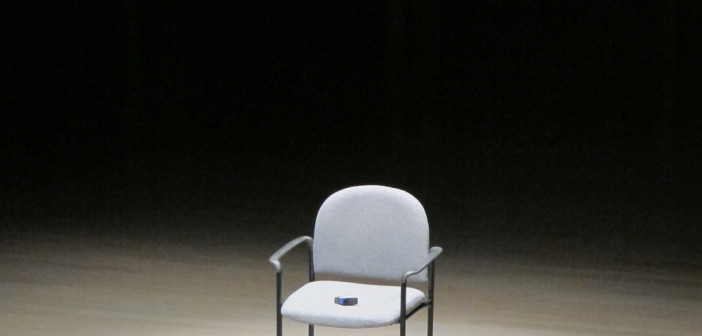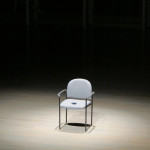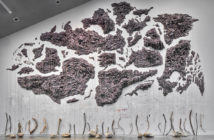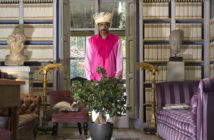Andrea Fraser suddenly started shaking. From my seat at the very back of the theater, I couldn't quite tell: was she crying? Sobbing, even? "Don't cry Andrea," I murmured. Empathy coursed through me: I was reaching out to her, I wanted to hold her, calm her, and felt suddenly irritated at the person who had prompted this unexpected reaction. Why did they have to 'go there'? "Oh, you really want to go there?" had been her response before she began shaking.
I recalled a beautiful text Fraser once wrote about the effect Fred Sandback's work1 had had on her during her first visit to Dia:Beacon. It had made her cry. Maybe she cries easily, I thought. Perhaps we don't need to feel so bad for bringing her to tears. Maybe she's just tired. She does look a little sick, with her tissues and glass of water.
She went there. And in that moment of vulnerability we witnessed, she'd drawn us closer still. So there was gratitude too in my mixture of feelings: gratitude that someone in the audience had asked a direct enough question to prompt a candid response. We'd been listening to the panel talk psychoanalytic theory for thirty minutes. Maybe she was crying with relief.
Andrea Fraser had just concluded a performance of Men on the Line, KPFK, 1972 and was being engaged in a Q&A by ICA Curator Helen Molesworth and Gregg Bordowitz, an artist and ACT UP member whose work appears in the exhibition This Will Have Been: Art, Love & Politics in the 1980s. The performance was phenomenal. In a wide-collared shirt and khaki flares, Fraser had embodied four separate men—their opinions, mannerisms, vocabulary—as they took turns discussing their involvement with the nascent Feminist movement. In 1972, the men she incarnated had actually taken part in a live radio broadcast on KPFK during which they engaged in group process, sharing how they were experiencing, struggling with and feeling about women's liberation.
"A real sense of equality: that's what I have with my third wife," shared one of the men.
"They've got their thing to do and that's OK," said another.
"I have a feeling that they're talking about me behind my back," confessed the third.
These thoughts were expressed. They were aired. They seem at once comical in their naïveté and, at times, self-congratulatory tone, yet uncomfortably current—are these thoughts still felt today but not spoken? Is equality for women still our "thing to do" and god bless? While most perceive equal rights and opportunities for women as second nature, in actuality we're still fighting a gender wage gap. Three days ago, the Pentagon lifted restrictions on the roles women can have in the military, acknowledging their capabilities and their continued engagement in direct combat. Is that progress? I suppose. It might be something more to cry about.
Fraser's performance was moving not just because of the sentiments uttered by the men in conversation and their relevance or disconnect from today's ideas of gender roles. Nor simply because conversations around inequity still apply in other regards. It was moving because she was possessed by them. As each voice emerged from her mouth, her body language shifted slightly: hands on thighs was one guy, arm on backrest was another. She'd turn towards the empty stage on the right or the left, as she modulated her voice to mimic each position. That's what she later called them: not characters but positions.
Androgynous, Andrea feels generally. Some of these positions may be ones she espouses. Others might be repulsive to ingest and internalize, but not necessarily because she has rejected them. "Sometimes it's very difficult to empathize with parts of oneself, particularly when they've developed in difficult relationships," she admitted. Amen, sister.
The performance ended with Fraser hugging herself—the men inside her had let their expression of solidarity turn physically affectionate. It was one of the positive outcomes of their involvement with feminism, they said, as they cried a little.
After that display of quadrupled masculinity, which Fraser broke down during the conversation? Who was crying and why were they crying? Was she really crying? (Why am I so hung up on this?) Could crying have been a way to rebalance, exorcising the male position(s) by giving in to a more stereotypically female display of emotion? Is it a defense mechanism that gets triggered in her the way blushing gets triggered in me? Is she playing with us? We asked for it. Was it a pure demonstration of affect, the concept Bordowitz and Molesworth had been attempting to explain and address for the past half hour? Or just maybe she wanted to 'go there' and tell us her father had been one of the four men on the line. And maybe once she went there, she needed a cry.
- Andrea Fraser performed Men on the Line: KPFK, 1972 at Boston’s ICA, 24 January 2013 Photo: Stephanie Cardon
[1] Andrea Fraser, Why Does Fred Sandback's Work Make Me Cry? The MIT Press: Grey Room, No. 22 (Winter, 2006), pp. 30-47





